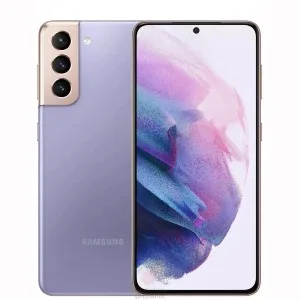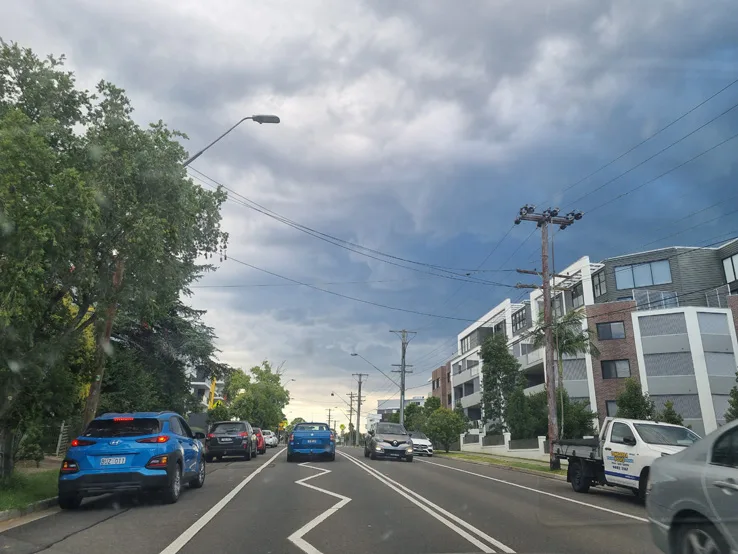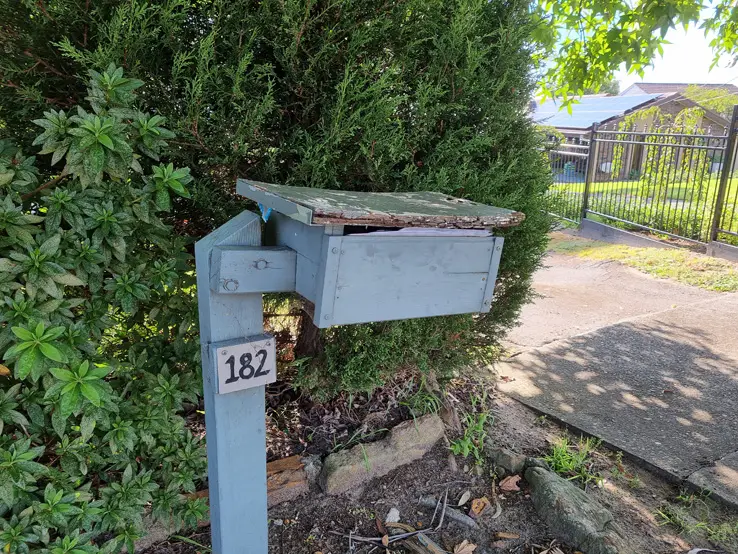Samsung Galaxy S21 Review: Pocket rocket (with a few misfires)
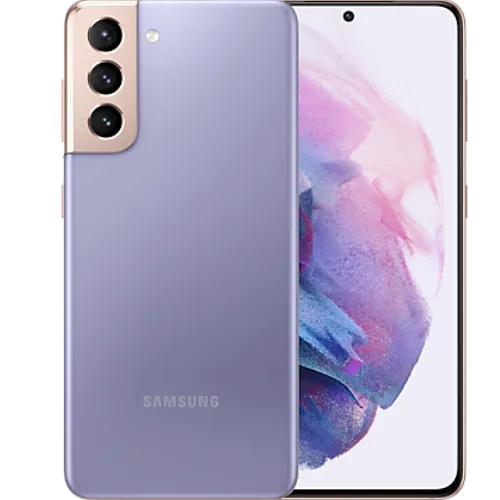
-
- Battery Score
3
- Camera Score
3.5
- Design Score
4
- Performance Score
4
- Battery Score
3
Summary
Quick Verdict: Samsung’s Galaxy S21 delivers a more affordable flagship experience in a very nice form, although the lack of a charger, microSD expansion and Qualcomm’s best chips do mean it’s not quite the perfect smaller flagship phone Samsung says it is.
- Contour cut body design is really nice
- Easy to use camera
- Great in-display fingerprint sensor
- Lower cost than last year’s S20
- Exynos model isn’t quite as snappy as the international Snapdragon models
- No storage expansion
- No headphones or bundled charger
- Battery can drain fast
Details
Pricing & Availability
| RRP | $0 |
| Launch date | 2021-01 |
The Samsung Galaxy S21 is the "entry level" model of the Galaxy S21 family with a focus on a small size and a smaller hit to your wallet. It's a smart move on Samsung's part to slice down the pricing of its flagship phones in a time when many of us are feeling the pinch and the justification for flagship phones is challenged by some really good mid-range options.
However, the Galaxy S21 isn't a huge leap over 2020's best flagship phones – and in some cases it can't even measure up to them – and what Samsung's cut out of the Galaxy S21 is just as important as what it's left in. If you're a big Samsung fan after a small-but-powerful handset it's an easy recommendation, as long as you're aware of its shortcomings.
Looking for the latest model? Here's our reviews of the Samsung Galaxy S22 and S22+.
Design
Design
- 6.7 inch 120Hz display
- Only Full HD+ resolution
- Contour cut hides camera bump beautifully
- Range of colour choices
- Great in-display fingerprint sensor
- No headphone jack
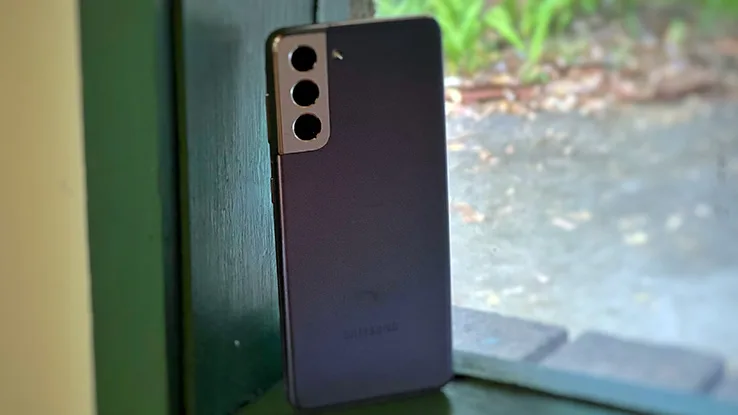
There's been a trend of late towards delivering more powerful phones in smaller form factors, and the Galaxy S21 is definitely on trend here.
The Galaxy S21 features a 6.7 inch display, which might not sound like it's "small", but this is on a phone with virtually no bezels and a tiny holepunch camera at the front, so it's basically all screen, all the time.
By way of comparison, I placed the Galaxy S21 on top of the smaller-screened Aspera AS6, and despite that phone only featuring a 5.99 inch display, it's a much larger phone to hold. Those bezels really do add up, and their absence makes for a phone that very easily slips into a pocket or bag.
The Galaxy S21 supports up to 120Hz refresh rates, but like prior Samsung phones, this isn't something that you switch to or from precisely. If you want to save battery life you can opt for 60Hz only refresh rates, but if you want 120Hz, you get to choose a "dynamic" setting that scales up or down depending on content being displayed.
The Galaxy S21 is a little cheaper than its 2020 counterpart, and one way that Samsung's more subtly managed this is by dropping the effective screen resolution. At Full HD+ (2400x1080) this isn't Samsung's best display, although most users are unlikely to massively spot the difference on a display of this size.
Samsung produces the Galaxy S21 in four different colour variants. There's a choice of "Phantom Grey", "Phantom White", "Phantom Pink" or "Phantom Violet" to choose from. Samsung sent me a Phantom Violet model to test out, and while it's not a hue that notably appeals to me personally, it's certainly quite striking.
What's more striking is the way that Samsung has rather cleverly minimised the camera bump on the rear of the phone. It's housed in a "contour cut" bump that merges seamlessly into the side of the phone in either gold (for the Violet and Pink models), Silver (white) or Grey (grey) that matches the side metallic tint. Again, I personally think the gold is a little garish next to the violet, but then the grey/grey combination looks great.
Samsung's been using some of the best in-display ultrasonic fingerprint sensors in its Galaxy S and Galaxy Note phones for a while now, and the Galaxy S21 is no exception. The enrolment process is a little more picky than many other fingerprint sensors, but once you're set up, the odds of false negatives when unlocking seem very low. I've had it happen once, and I tend to check my phone dozens (if not hundreds) of times a day.
Yes, that's probably symptomatic of a bigger problem on my part, but the reality here is that the Galaxy S21's fingerprint sensor works very well indeed.
Samsung dropped headphone jacks for the Galaxy S20 range, and they're not back for the Galaxy S21. However, what's also missing in action is any in-box headphones of any sort. Samsung would of course like it if you rushed out and bought a pair of Galaxy Buds Live or Galaxy Buds Pro to go with your shiny new phone.
Samsung's essentially following Apple's lead here, except that the headphones it used to include in-box tended to be pretty good, so they're even more missed than with the generally lousy in-box Apple equivalents.
Camera
Camera
- Triple lens rear camera
- Single take is more creative
- Space Zoom still looks awful at maximum range
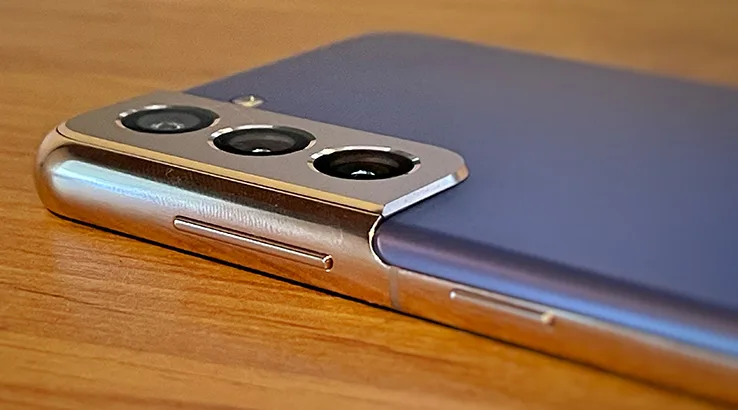
There's little doubt that the Galaxy S21 Ultra 5G is the true camera flagship of the Galaxy S21 series, but Samsung has opted to make no difference between the two smaller models of its S21 handsets. That means that the cameras in the Galaxy S21 and Galaxy S21+ are absolutely identical.
At the rear you'll find a primary wide 12MP sensor, ultra-wide 12MP sensor and 64MP 3x optical telephoto sensor. That telephoto resolution bump is there to enable Samsung's "Space Zoom" feature, which can crunch zoom up to an impressive sounding 30x, with the promise of AI-led Zoom Lock to enhance photos even at that range.
They're impressive numbers, but they don't really match up to the experience of using zoom pushed out to that extent.
To test that out, I went out shooting with the Galaxy S21, and spotted a bird perching on a far-off tree.
Here's a standard ultrawide shot of the street, and all is good:
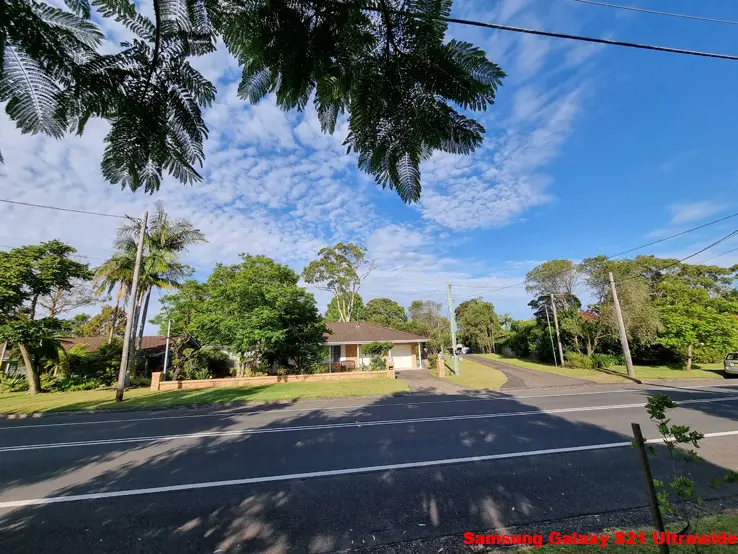
Switching to the standard wide lens, and it continues just fine, as you'd expect:
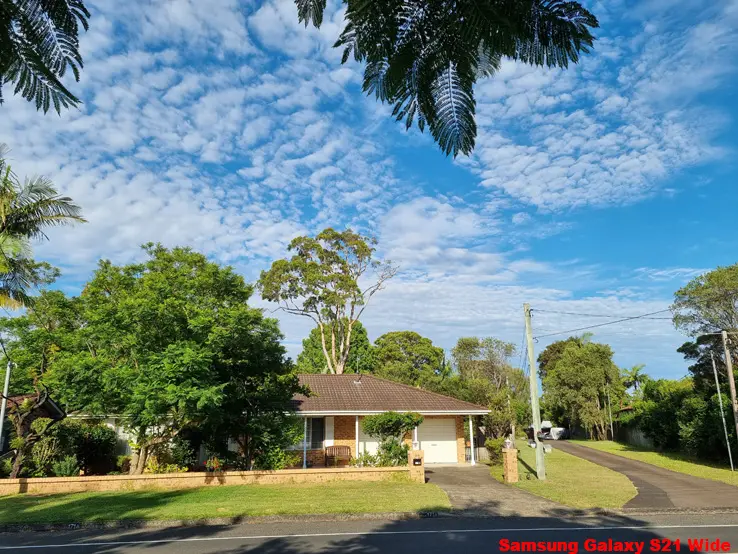
And the standard 3x telephoto shot – the default zoom when switching to zoom mode on the Galaxy S21 – is also decent.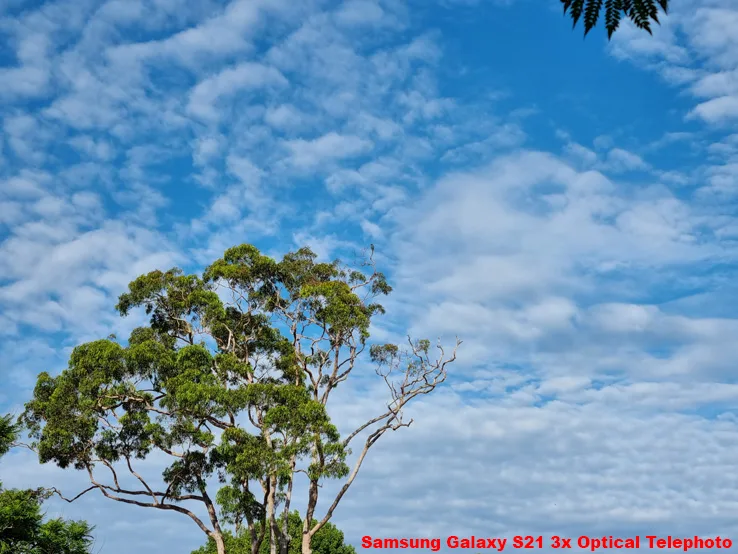
You could take this shot at full 64MP resolution and crop too, and that's probably your better bet for a pleasing composition, although you can push it to 10x and still get a decent shot: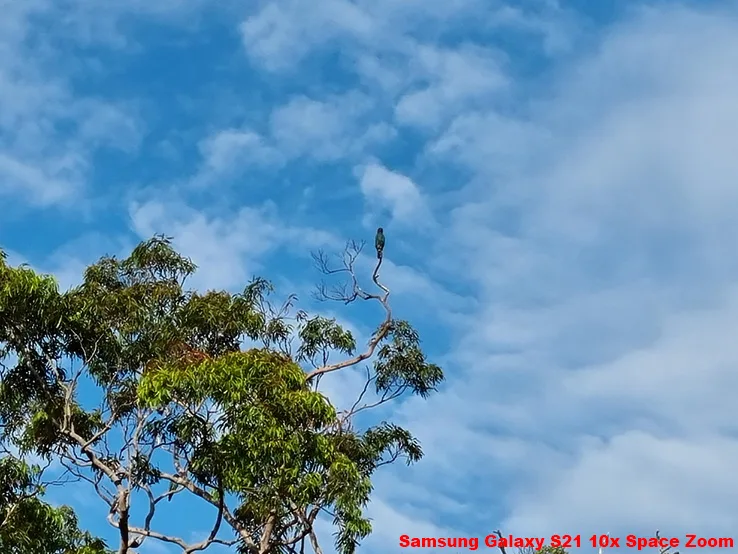
At 30x zoom however, and without a tripod, forget it. The results are impressive in a peering-in-on-the-world sense, but they don't produce pleasing photos:
That's not to say that you can't take pleasing photos or video with the Galaxy S21. Those triple lenses do give you good flexibility for camera creativity at all levels. If you're not confident in your camera skills, Samsung's updated its "Single Take" feature which captures from every lens for an adjustable period of time before presenting you with a range of still and video captures that are AI-adjusted and filtered to cover a variety of moods and capture styles.
Those who prefer a little more directorial control may well like the new Director mode, which lets you select your rear shooting lenses with an onscreen display showing each shot type before you make it. You can even drop your own selfie camera as an overlay into the shot if that kind of vlogging is your jam.
Performance
Performance
- Exynos 2100 is decent, but the Snapdragon 888 would have been better
- Hey Samsung, where's my microSD expansion?
- 5G, but it's only sub-6Ghz in Australia
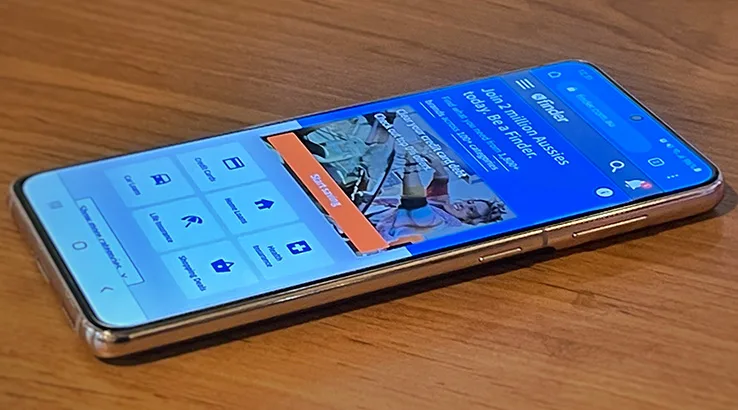
Samsung's Galaxy S phones have long fallen into a predictable pattern each year. Internationally the models most frequently seen run on that year's flagship Qualcomm Snapdragon platform. For 2021 that's the Snapdragon 888. Here in Australia and a smaller number of other territories, we instead see Samsung's own flagship Exynos silicon. This year, that's the Exynos 2100.
This is exactly the story for the Galaxy S21 in Australia and for the model I've been testing out. Samsung's own silicon is typically a step or two behind Qualcomm's best, but I was keen to see how well Samsung itself could catch up to the already impressive performance lead of Apple's own A14 Fusion processor.
To test that out, I ran Geekbench 5's CPU test over the Galaxy S21, to give a comparative performance picture relative to the current crop of iPhones, as well as Samsung's most recent premium-priced phones:
As you'd expect, the Galaxy S21 does outpace last year's Samsung phones, although not by as much as you might hope. Looking over international reviews and benchmarks for the Qualcomm Snapdragon 888 variant, it certainly appears as though we're getting a much slower phone here in pure performance terms.
Benchmarking for graphics performance shows an interesting pair of comparison points between Samsung and Apple's best phones. If you're looking at OpenGL performance via 3DMark's older Slingshot Extreme benchmark, Samsung's phones are best of breed, although the Galaxy S21 actually trails several older Samsung models here.
Flip that to the newer 3DMark WildLife benchmark, however, and Apple takes the lead. Here's the comparative data:
Alongside the Exynos 2100, the Samsung Galaxy S21 ships with 8GB of RAM and either 128GB or 256GB of onboard storage. The big departure here for Samsung is that there's no capacity for microSD storage expansion. Samsung's dabbled in this space before with phones like the Galaxy Z Fold 2 or Galaxy S20+ 5G, but this is the first time it's had an entire phone family drop storage expansion wholesale. Yes, Apple does this to, and so does Google, but it's still an annoying limitation if you do need more storage space directly on your handset.
Actual performance on the handset is quite good, with Android 11 overlaid with Samsung's own "OneUI" launcher in play. One quick trick here if you do keep the Galaxy S21 in dynamic screen mode is that any game that can't handle that 120Hz upshift may run unreasonably fast unless you drop it to 60Hz specifically.
The Galaxy S21 is 5G-capable, as you'd expect out of any 2021 handset, but the models sold in Australia are only compatible with sub-6Ghz 5G networks.
For now, that's fine because the only 5G networks we have are sub-6Ghz models, but it means that they'll never hit the heights of mmWave speeds. There are international models of the Galaxy S21 that combine both Sub-6Ghz and mmWave compatibility, but so far very few phones have launched in Australia with dual sub-6Ghz/mmWave compatibility.
It's a little surprising to see Samsung, a pioneer locally in available 5G phones not offer the feature given they're clearly capable of making Galaxy S21 phones that can handle both network types.
Battery life
Battery life
- 4,000mAh battery gives inconsistent results
- 5G can be a real battery hog
- No charger in the box
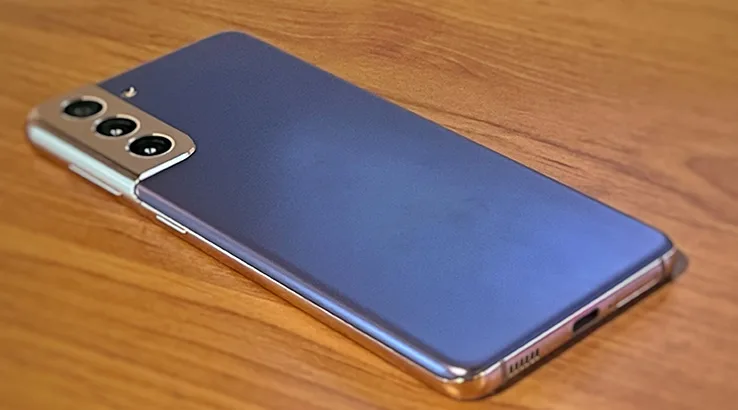
The smallest member of the Galaxy S21 family was always going to have the smallest battery. After all, if you've only got a small frame to pack battery capacity into, you're going to struggle to cram it all in while keeping the phone appreciably thin.
Still, this is one area where historically we've seen Samsung's Exynos processors shine. They may not be as nippy as Qualcomm's Snapdragon processors, but you've often had the tradeoff of better battery life.
So where does the Exynos 2100 in the Australian model of the Galaxy S21 sit? It's a complex question, because my benchmark results stood in contrast to my real-world experience.
Our standard benchmark for battery performance is to fully charge a phone, set brightness to maximum and volume to moderate and then loop a 1080p YouTube video through the handset for an hour. Phones that can manage above 90% are typically good to go for a day's usage, while those that fall below that mark can struggle.
The nature of the Galaxy S21's 120Hz capable screen meant that the test had to be run twice; once at standard 60Hz mode, and then once with the phone's "dynamic" refresh rate setting in play.
Here's how the Samsung Galaxy S21 compared against other flagship Samsung and Apple handsets:
That would suggest that despite its smaller frame and battery, the Galaxy S21 should be able to last through a day's moderate usage.
Having used the Galaxy S21 over the last week, I'm not so sure. More often than not, by the time the sun was setting, I was searching out a charger to top it up, because its battery percentage was falling dramatically. This may relate to it switching to and from 5G networks, as I'm in an area that should be covered by Telstra's 5G network, and it's a notable battery hog.
The other challenge here lies in the fact that when I did need to hunt out a charger, either wired or wireless, there was no point in looking in the Galaxy S21's box to find one. Despite rather publicly mocking Apple for removing the charger back when the Apple iPhone 12 series phones launched, it's followed suit for the Galaxy S21 family. You'll need an existing charger to hand to put any power into the Galaxy S21 once its battery runs low.
Should you buy the Samsung Galaxy S21?
- Buy it if you want a small powerful 5G-capable Android flagship.
- Don't buy it if you want expandable storage or great battery life.
The Samsung Galaxy S21 sits in an awkward position. It's probably better value than the Galaxy S21+, because that's pretty much just the S21 with a larger screen, but it's also got to see off the challenges of some of 2020's best mid-range phones – including Samsung's own Galaxy S20 FE.
At launch, there's not quite enough in the Galaxy S21's favour to make it a must-buy prospect over and above the S20 FE, especially as that's a phone that's started to see some serious discounts hit the market. Over time that may well change, and we should see the real impact of international models with that more desirable dual-band 5G and Snapdragon 888 become available too.
If you were looking at an upgrade from an older Samsung phone, the standard advice still applies here too. If you've got a Samsung S20, while the Galaxy S21 is a better handset, there's not much point in upgrading after only a year's time. Those with older handsets will find more of a performance boost – but again, there's the S21 FE, or if your budget can cop to it, the fancier Galaxy S21 Ultra 5G to consider.
Pricing and availability
Specifications
Display
Camera
Physical Dimensions
Connectivity
Power, storage and battery
Device features
Images: Alex Kidman
More Finder reviews
- Samsung Galaxy S25 Ultra review – Still an Android powerhouse
- iPhone 16 and 16 Plus review – Closing the gap
- iPhone 16 Pro and 16 Pro Max review – Shockingly good battery life
- Google Pixel 9 Pro XL review – Fantastic phone, even better cameras
- Samsung Galaxy Z Flip 6 review: Great phone held back by price
Alex Finder
Senior editor
You are about to post a question on finder.com.au:
- Do not enter personal information (eg. surname, phone number, bank details) as your question will be made public
- finder.com.au is a financial comparison and information service, not a bank or product provider
- We cannot provide you with personal advice or recommendations
- Your answer might already be waiting – check previous questions below to see if yours has already been asked
Finder only provides general advice and factual information, so consider your own circumstances, or seek advice before you decide to act on our content. By submitting a question, you're accepting our Terms Of Service and Finder Group Privacy & Cookies Policy.
This site is protected by reCAPTCHA and the Privacy Policy and Terms of Service apply.

